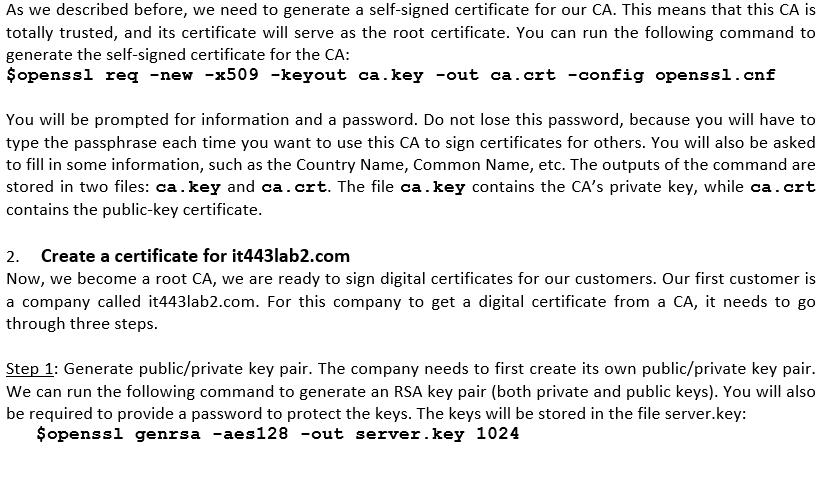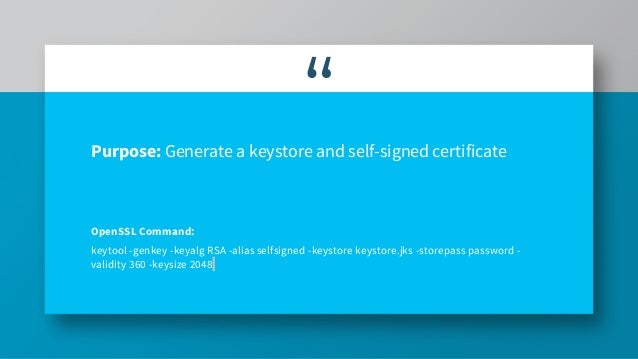Introduction
A Certificate Signing Request (CSR) is the first step in setting up an SSL Certificate on your website. SSL certificates are provided by Certificate Authorities (CA), which require a Certificate Signing Request (CSR).
Generate RSA private key (2048 bit) openssl genrsa -out private.pem 2048 Generate a Certificate Signing Request (CSR) openssl req -sha256 -new -key private.pem -out csr.pem Generate RSA private key (2048 bit) and a Certificate Signing Request (CSR) with a single command openssl req -new -newkey rsa:2048 -nodes -keyout server.key -out server.csr Convert private key to PEM format openssl rsa -in server.key -outform PEM -out server.pem. OpenSSL can generate several kinds of public/private keypairs. RSA is the most common kind of keypair generation. Other popular ways of generating RSA public key / private key pairs include PuTTYgen and ssh-keygen. 1 Generate an RSA keypair with a 2048 bit private key.
This guide will instruct you on how to generate a Certificate Signing Request using OpenSSL.
- Access to a user account with root or sudo privileges
- A command line/terminal window
- If you’re working on a remote server, an established SSH connection to the server
- OpenSSL needs to be installed on your system to generate the key
- A text editor, such as nano, to view your key
Open a terminal window. Use your SSH connection to log into your remote server.
Note: If you are working locally, you don’t need an SSH connection. Also, most Linux systems will launch a terminal window by pressing Ctrl-Alt-T or Ctrl-Alt-F1.
Step 2: Create an RSA Private Key and CSR
It is advised to issue a new private key each time you generate a CSR. Hence, the steps below instruct on how to generate both the private key and the CSR.
Make sure to replace your_domain with the actual domain you’re generating a CSR for.

The commands are broken out as follows:
- openssl – activates the OpenSSL software
- req – indicates that we want a CSR
- –new –newkey – generate a new key
- rsa:2048 – generate a 2048-bit RSA mathematical key
- –nodes – no DES, meaning do not encrypt the private key in a PKCS#12 file
- –keyout – indicates the domain you’re generating a key for
- –out – specifies the name of the file your CSR will be saved as
Note: Use 2048-bit key pairs. The 4096-bit key pairs are more secure, however, they require a lot more server resources.
Your system should launch a text-based questionnaire for you to fill out.
Enter your information in the fields as follows:
- Country Name – use a 2-letter country code (US for the United States)
- State – the state in which the domain owner is incorporated
- Locality – the city in which the domain owner is incorporated
- Organization name – the legal entity that owns the domain
- Organizational unit name – the name of the department or group in your organization that deals with certificates
- Common name – typically the fully qualified domain name (FQDN), i.e. what the users type in a web browser to navigate to your website
- Email address – the webmaster’s email address
- Challenge password – an optional password for your key pair
Generate Rsa Public Key Openssl
Please take into account that Organization Name and Unit Name must not contain the following characters:
< > ~ ! @ # $ % ^ * / ( ) ?.,&
Once the software finishes, you should be able to find the CSR file in your working directory.
You can also enter the following:
The system should list out all certificate signing requests on the system. The one that matches the domain name you provided in Step 2 appended with the .csr extension is the one you need to look into.
Step 5: Submit the CSR as Part of Your SSL Request
You can open the .csr file in a text editor to find the alphanumeric code that was generated. Generate aes 256 key c.
Enter the following command:
This text can be copied and pasted into a submittal form to request your SSL certificate from a Certificate Authority.
Make sure you copy the entire text. Some CAs may allow you to simply upload the .csr file you generated. Below is an example of a CSR.
You needn’t send the private key to the CA. Once you get your SSL certificate, the private key on the server will bind with it to encrypt communication.
Now you know how to generate an OpenSSL certificate signing request. Before submitting the CSR to a certificate authority, we recommend verifying the information it holds. Use one of the widely available online CSR decoders.
SSL is a crucial protocol for securing traffic between a website and its visitors. It helps to protect sensitive information online, such as credit card data.

Next, You Should Also Read:
Generate CSR - OpenSSL
Introduction
This article provides step-by-step instructions for generating a Certificate Signing Request (CSR) in OpenSSL. This is most commonly required for web servers such as Apache HTTP Server and NGINX. If this is not the solution you are looking for, please search for your solution in the search bar above.

Switch to a working directory
GNU/Linux & Mac OS X users:
Open a terminal and browse to a folder where you would like to generate your keypair
Openssl Generate Rsa Private Key
Windows Users:
Navigate to your OpenSSL 'bin' directory and open a command prompt in the same location.
Generate a CSR & Private Key:
openssl req -out CSR.csr -new -newkey rsa:2048 -keyout privatekey.key
Windows 7 Home Premium Product Key is entirely analyzed, and the working list can be downloaded from either the link is given below. Or you can merely just copy the Product key independently and check your Windows 7 high quality during installation in the licensing step. Win 7 home product key generator.
To generate a 4096-bit CSR you can replace the rsa:2048 syntax with rsa:4096 as shown below.
openssl req -out CSR.csr -new -newkey rsa:4096 -keyout privatekey.key
Openssl Generate Rsa Key Pair
Note: You will be prompted to enter a password in order to proceed. Keep this password as you will need it to use the Certificate.
Fill out the following fields as prompted:
Note: The following characters can not be accepted: < > ~ ! @ # $ % ^ * / ( ) ?.,&
| Field | Example |
|---|---|
| Country Name | US (2 Letter Code) |
| State or Province | New Hampshire (Full State Name) |
| Locality | Portsmouth (Full City name) |
| Organization | GMO GlobalSign Inc (Entity's Legal Name) |
| Organizational Unit | Support (Optional, e.g. a department) |
| Common Name | www.globalsign.com (Domain or Entity name) |
You should now have a Private Key (privatekey.key) which should stay on your computer, and a Certificate Signing Request (CSR.csr), which can be submitted to GlobalSign to sign your public key. Each of these files can be viewed in a plain text editor such as Notepad, TextEdit, Vi, Nano, and Notepad++.